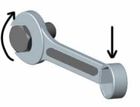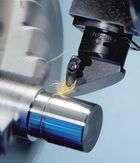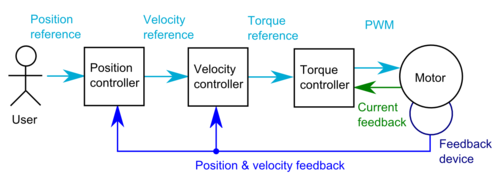Control modes
There are three main control modes in motion & motor control are torque, velocity and position control.
Torque control
Torque control mode makes motor a torque or force transducer. I.e. user sets torque setpoint to 1 Nm, then motor will produce 1 Nm torque regardless of spinning speed. In torque mode user can not set limits to velocity or position.
- Typical applications
- Feeding/pulling/winding
- Racing/flight simulators
- Final stage in velocity or position controller
- Non-motion applications: high power adjustable current source
Velocity control
Goal of velocity control is to regulate motor speed. I.e. if user velocity setpoint is 500 rpm, then motor attempts to rotate exactly at 500 rpm no matter how much load is attached to motor. In velocity mode user can set limits for torque but not for position.
- Typical applications
- Spindles
- Feeding
- Fans & pumps
- Screw tightening robot when used with torque limit
- Intermediate stage in position control
Position control
Position control mode attempts to provide precision positioning. Motor follows setpoint set point and if set point is kept constant, motor holds position even if external forces attempt to displace it. In position mode user can set limits to torque and velocity.
- Typical applications
- CNC
- Pick & place machines
- 2D/3D printing
- Robotics
- Welding
Controller structure
VSD drives use cascaded controllers. So for example in velocity mode, torque controller and velocity contoller are connected in series so that torque setpoint is generated by velocity controller. Position mode is same as velocity controller except the velocity setpoint is generated by position controller.
Cascaded structure leads to more flexible features and enables higher dymamic performance compared to direct PWM or torque control from position controller.
- Torque controller stucture
- User torque rererence → Torque limiter → Torque controller outputs motor PWM
- Velocity controller stucture
- User velocity setpoint → Velocity limiter → Velocity controller outputs torque rererence → Torque limiter → Torque controller outputs motor PWM
- Position controller stucture
- User position setpoint → Position controller outputs velocity setpoint → Velocity limiter → Velocity controller outputs torque rererence → Torque limiter → Torque controller outputs motor PWM
Limiters simply cut and saturate setpoint signal if user specified torque/velocity limit is exceeded.
In no event the Product Information or parts hereof shall be regarded as guarantee of conditions or characteristics. The Product Information or any part thereof may also not be regarded as a warranty of any kind. No liability of any kind shall be assumed by Author with respect to Product Information or any use made by you thereof, nor shall Author indemnify you against or be liable for any third party claims with respect to such information or any use thereof.
As content of this Wiki may be edited by user community, Granite Devices Oy or it's affiliates do not take any responsibility of the contents of this Wiki. Use information at your own risk. However, Granite Devices staff attempts to review all changes made to this Wiki and keep information trustworthy.
Without written consent, Granite Devices' Products or Intellectual Property shall not be used in situations or installations where living beings, material property, or immaterial property could be harmed by the operation, features or failures of Product. Products may only be used in a way where hazards like moving parts, electric shock, laser radiation, or fire can't be realized even if the content of this Wiki would suggest otherwise.



